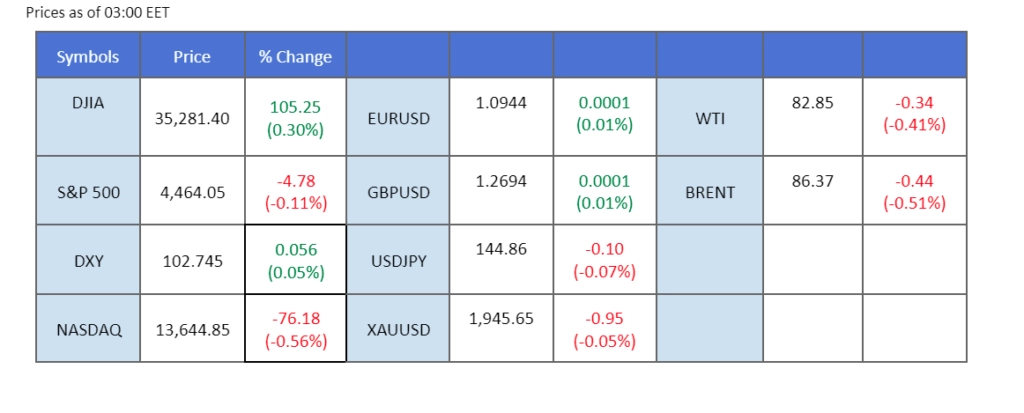
Chinese equity markets, including the Hong Kong stock market, are grappling with selling pressures due to the nation’s escalating property concerns, which have cast a shadow over market sentiment. Compounded by the lacklustre Chinese economic recovery, the Australian dollar has been trading at its lowest point against the U.S. dollar since May. As the world’s foremost commodities importer, China significantly influences the commodity-linked Australian dollar. Concurrently, oil prices have retreated after their bullish surge that persisted from late June. The oil market is confronted by headwinds stemming from the worsening economic outlook in Europe and China. This is occurring despite efforts by major oil producers, such as Saudi Arabia and Russia, to curtail oil supply in order to stabilise prices.
Current rate hike bets on 20th September Fed interest rate decision:
Source: CME Fedwatch Tool
0 bps (86%) VS 25 bps (14%)


The US Dollar continues its impressive surge, bolstered by a backdrop of encouraging economic indicators. A recent report from the Bureau of Labor Statistics revealed a significant upturn in US wholesale inflation for July, countering a year-long trend of moderation. The Producer Price Index, a key metric tracking price fluctuations for businesses, soared by 0.80% annually, surpassing market projections that had anticipated a 0.70% increase.
The dollar index is trading higher following the prior breakout above the previous resistance level. MACD has illustrated increasing bullish momentum. However, RSI is at 71, suggesting the index might enter overbought territory.
Resistance level: 103.45, 104.50
Support level: 102.60, 102.05
Following the release of the robust Producer Price Index report, the gold market experienced a marginal decline. The unexpected surge in inflation data stoked concerns about potential Federal Reserve rate hikes aimed at curbing rising inflationary pressures. Investors eyed this development cautiously, evaluating its implications for future monetary policy decisions.
Gold prices are trading flat while currently testing the support level. MAD has illustrated diminishing bullish momentum, while RSI is at 39, suggesting the commodity might trade lower after successfully breakout below the support level since the RSI stays below the midline.
Resistance level: 1930.00, 1945.00
Support level: 1910.00, 1890.00
The USD/JPY pair remains on an upward trajectory, reaching a pivotal psychological barrier at 145.00. The Japanese yen’s ongoing depreciation is attributed to the Bank of Japan’s persistent implementation of an ultra-loose monetary policy, even though the nation’s inflation rate is sustainable. The growing disparity in interest rates among global counterparts has acted as an obstacle for the Japanese yen to recover from its extended period of decline. Nevertheless, market speculation is rife that Japanese authorities are contemplating intervention in the foreign exchange market to stabilise the Japanese yen’s value, particularly if the USD/JPY pair breaches the 145.0 threshold.
The USD/JPY pair had a gain of more than 2% last week. The RSI has broken into the overbought zone while the MACD continues to climb suggesting the bullish momentum for the pair is strong.
Resistance level: 146.00, 147.25
Support level: 143.25, 142.00
The appreciating dollar has impeded the euro’s ability to maintain its position, leading it to approach a significant support threshold of around 1.0925. The dollar’s momentum was boosted by U.S. Producer Price Index (PPI) data that surpassed expectations, propelling it towards a pivotal resistance mark of $103.00. Amid these developments, investors are keenly anticipating the forthcoming eurozone GDP figures and industrial production data set to be unveiled on Wednesday. These data points are expected to provide insights into the euro’s resilience, particularly as it teeters on the edge of breaking below its critical support level.
Euro failed to form a solid trend reversal trend and is currently traded toward its crucial support level. The RSI is moving toward the oversold zone while the MACD has broken below the zero line suggesting the bearish momentum has overshadowed the bullish momentum.
Resistance level: 1.1000, 1.1090
Support level: 1.0950, 1.0850
The Cable, representing the GBP/USD currency pair, remains confined beneath its downtrend resistance level, signalling a prevailing bearish sentiment for the British Pound. Positive economic indicators have additionally bolstered the U.S. dollar, propelling it past the significant mark of 103.00. While the U.K. ‘s GDP report from last Friday surpassed expectations and initially lifted the Sterling against the dollar, this momentum was swiftly reversed as the dollar reasserted its dominance. Meanwhile, investors are keeping a close watch on the upcoming release of the U.K.’s Consumer Price Index (CPI) scheduled for Wednesday. This data release is anticipated to offer insights into the strength of the British Pound in the context of current market dynamics.
GBP/USD is testing its near support level at 1.2670 while the pair is trading in strong bearish momentum. The RSI is hovering in the lower region while the MACD failed to break above the zero line suggesting the bearish momentum is strong.
Resistance level: 1.2740, 1.2860
Support level: 1.2605, 1.2500
Despite mounting US Treasury yields in the wake of the inflation report, the US equity market exhibited a modest rebound. Investor sentiment found support in the backdrop of satisfactory second-quarter corporate earnings results. Notably, the S&P 500’s performance has been a bright spot, with an impressive number of companies surpassing analysts’ profit projections.
The S&P 500 is trading slightly higher following the prior rebound from the support level. However, MACD has illustrated increasing bearish momentum, while RSI is at 38, suggesting the index might be traded lower after its breakout below the support level since the RSI stays below the midline.
Resistance level: 4605.00, 4805.00
Support level: 4245.00, 3900.00
The Australian Dollar faced ongoing headwinds as concerns over potential geopolitical tensions between the US and China persist. Escalating uncertainties surrounding these Chinese-proxy currencies stem from recent measures taken by the US, UK, and European Union to restrict investments in Chinese technology firms. These developments have prompted cautious market sentiment and prompted responses from China’s commerce ministry, emphasising the potential for further turbulence.
AUD/USD is trading lower while currently testing thes support level. MACD has illustrated increasing bearish momentum, while RSI is at 35, suggesting the pair might extend its losses after breakout since the RSI stays below the midline.
Resistance level: 0.6725, 0.6615
Support level: 0.6495, 0.6415
Despite a minor setback attributed to technical corrections, the oil market remains on a positive trajectory. The International Energy Agency (IEA) maintains its sanguine outlook for oil prices, citing robust global demand and tightening supply conditions. A noteworthy milestone was reached in June, with oil demand surging to a historic pinnacle of 103 million barrels per day. The IEA’s forecast anticipates a potential new peak in August, underlining the sector’s resilience.
Oil prices are trading lower while currently testing the support level. MACD has illustrated increasing bearish momentum, while RSI is at 45, suggesting the commodity might extend its losses after breakout since the RSI stays below the midline.
Resistance level: 86.10, 89.25
Support level: 82.75, 78.90

Trade forex, indices, cryptocurrencies, and more at industry-low spreads and lightning-fast execution.

12 December 2023, 05:38 All Eyes On U.S. CPI Reading

11 December 2023, 05:23 Dollar Surges On Exceptional Jobs Data

8 December 2023, 05:50 Yen Rallies On BoJ Hawkish Comment

新註冊暫停
我們目前暫不接受新的註冊。
雖然目前無法接受新註冊,但現有用戶仍可照常進行挑戰和交易活動。